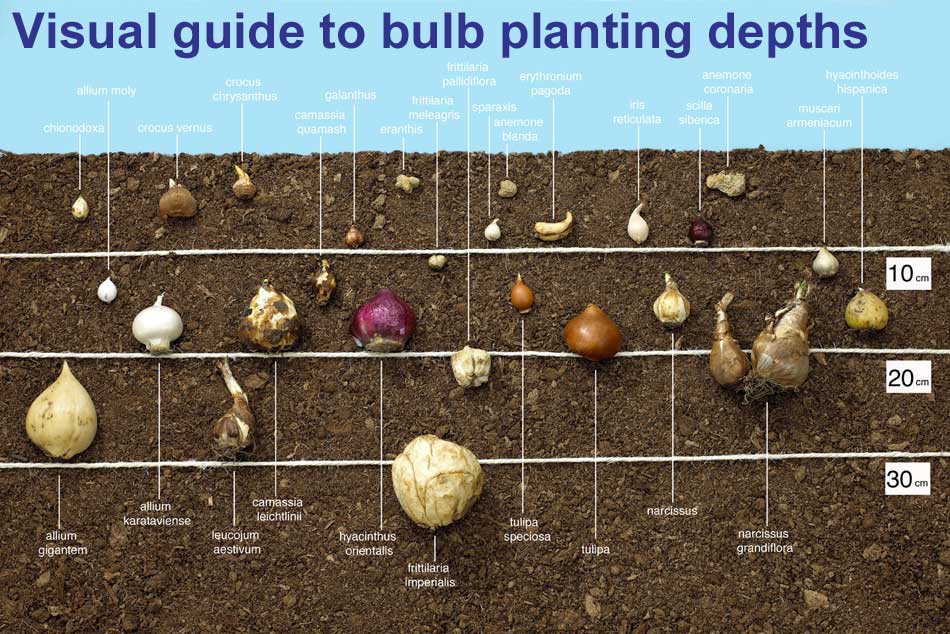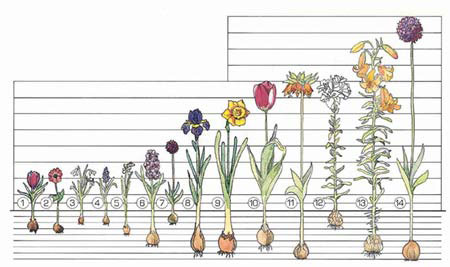Understanding Tulip Bulbs and Their Planting Requirements
Tulip bulbs are a popular choice for gardeners due to their vibrant colors, unique shapes, and relatively low maintenance requirements. To successfully plant on top of tulip bulbs, it’s essential to understand their growth habits, planting depths, and sunlight requirements. Tulip bulbs typically thrive in well-draining soil with a pH between 6.0 and 7.0. They require a period of cold temperatures to induce flowering, making them an ideal choice for regions with cold winters.
In terms of planting depth, tulip bulbs should be planted at a depth of 2-3 times their height, depending on the variety. This allows the bulb to establish a strong root system and supports healthy growth. When planting tulip bulbs, it’s also crucial to consider their sunlight requirements. Most tulip varieties prefer full sun to partial shade, although some varieties can tolerate more shade than others.
When planting on top of tulip bulbs, it’s essential to choose companion plants that have similar growing conditions. This ensures that both the tulip bulbs and the companion plants receive the necessary sunlight, water, and nutrients to thrive. By understanding the specific needs of tulip bulbs, gardeners can create a beautiful and thriving garden display.
For those wondering, “can you plant on top of tulip bulbs?”, the answer is yes. However, it’s crucial to follow the correct planting procedures and choose companion plants that complement the tulip bulbs. By doing so, gardeners can enjoy a stunning display of color and texture in their garden.
Can You Plant on Top of Tulip Bulbs? Exploring the Possibilities
One of the most common questions gardeners ask is, “can you plant on top of tulip bulbs?” The answer is yes, but it’s essential to understand the benefits and potential drawbacks of this technique. Planting on top of tulip bulbs can add depth and visual interest to your garden, but it requires careful planning and execution.
The benefits of planting on top of tulip bulbs include extended blooming periods, increased texture and color contrast, and improved soil health. By layering bulbs and plants, gardeners can create a dynamic and engaging garden display that changes throughout the growing season. Additionally, planting on top of tulip bulbs can help to suppress weeds and reduce the need for mulch.
However, there are also potential drawbacks to consider. Planting on top of tulip bulbs can lead to overcrowding, which can reduce air circulation and increase the risk of disease. It’s also essential to choose companion plants that have similar growing conditions and won’t compete with the tulip bulbs for resources.
To successfully plant on top of tulip bulbs, gardeners should select plants that are low-growing and won’t overshadow the tulips. Some good options include low-growing groundcovers, creeping thyme, and sweet woodruff. It’s also essential to plant the companion plants at the correct depth and spacing to ensure proper growth and development.
By understanding the possibilities and potential challenges of planting on top of tulip bulbs, gardeners can create a beautiful and thriving garden display. With careful planning and execution, this technique can add depth, texture, and visual interest to your garden, making it a unique and engaging space.
Choosing the Right Companion Plants for Tulip Bulbs
When it comes to planting on top of tulip bulbs, selecting the right companion plants is crucial for a successful and thriving garden display. The key is to choose plants that have similar growing conditions and won’t compete with the tulip bulbs for resources. Some excellent options for companion plants include low-growing groundcovers, creeping thyme, and sweet woodruff.
Low-growing groundcovers such as creeping juniper, sedum, and delosperma are ideal for planting on top of tulip bulbs. These plants spread quickly and can help to suppress weeds, reducing the need for mulch and maintenance. They also provide a beautiful, textured backdrop for the tulip bulbs to bloom against.
Creeping thyme is another excellent option for companion plants. This fragrant, low-growing herb can be planted on top of tulip bulbs and will spread quickly to form a dense mat. It’s also drought-tolerant and requires minimal maintenance, making it an ideal choice for busy gardeners.
Sweet woodruff is a charming, low-growing perennial that pairs perfectly with tulip bulbs. Its white, star-shaped flowers bloom in late spring and provide a beautiful contrast to the tulip bulbs. It’s also a low-maintenance plant that requires minimal care and can thrive in a variety of conditions.
When selecting companion plants for tulip bulbs, it’s essential to consider their growing conditions and ensure they won’t compete with the tulip bulbs for resources. By choosing plants with similar growing conditions, gardeners can create a beautiful and thriving garden display that will bloom for months to come.
How to Plant on Top of Tulip Bulbs: A Step-by-Step Guide
Planting on top of tulip bulbs can be a bit tricky, but with the right steps, you can create a beautiful and thriving garden display. Here’s a step-by-step guide to help you get started:
Step 1: Prepare the Soil
Before planting on top of tulip bulbs, it’s essential to prepare the soil. Start by loosening the soil to a depth of about 12 inches. Add a 2-inch layer of compost or well-rotted manure to improve soil fertility and drainage.
Step 2: Select the Right Plants
Choose companion plants that have similar growing conditions to tulip bulbs. Consider low-growing groundcovers, creeping thyme, or sweet woodruff. Make sure to select plants that won’t compete with the tulip bulbs for resources.
Step 3: Plant the Companion Plants
Plant the companion plants on top of the tulip bulbs, following the same planting depth and spacing guidelines as the tulip bulbs. Water well and keep the soil consistently moist during the first growing season.
Step 4: Plant at the Correct Depth
Plant the companion plants at the correct depth, taking into account the mature height of the plants. For example, if you’re planting creeping thyme, plant it about 2-3 inches deep, and about 6-8 inches apart.
Step 5: Mulch and Water
Apply a 2-inch layer of mulch around the plants to retain moisture and suppress weeds. Water regularly, but avoid overwatering, which can lead to root rot and other problems.
By following these steps, you can successfully plant on top of tulip bulbs and create a beautiful and thriving garden display. Remember to choose companion plants with similar growing conditions and plant them at the correct depth to ensure a successful outcome.
Tips for Successful Layering: Soil, Sunlight, and Watering
When planting on top of tulip bulbs, it’s essential to consider the soil, sunlight, and watering requirements to ensure a thriving garden display. Here are some tips to help you achieve success:
Soil Preparation
The soil should be well-draining and fertile to support the growth of both the tulip bulbs and the companion plants. Add a 2-inch layer of compost or well-rotted manure to improve soil fertility and drainage. Avoid using too much fertilizer, as this can damage the tulip bulbs.
Sunlight Requirements
Most tulip bulbs require full sun to partial shade, so choose a location that receives at least 6 hours of direct sunlight per day. However, some companion plants may require more shade, so be sure to check their specific requirements.
Watering Schedules
Water the soil consistently during the first growing season to establish a strong root system. Avoid overwatering, which can lead to root rot and other problems. Water the plants when the top 2-3 inches of soil feels dry to the touch.
Additional Tips
Avoid overcrowding, as this can lead to reduced air circulation and increased risk of disease. Plant the companion plants at the correct depth and spacing to ensure proper growth and development. Mulch around the plants to retain moisture and suppress weeds.
By following these tips, you can create a beautiful and thriving garden display when planting on top of tulip bulbs. Remember to choose companion plants with similar growing conditions and plant them at the correct depth to ensure a successful outcome.
Designing a Beautiful Spring Display with Layered Bulbs and Plants
When it comes to designing a beautiful spring display with layered bulbs and plants, the possibilities are endless. By combining tulip bulbs with companion plants, you can create a stunning display of color, texture, and fragrance that will bloom for months to come.
Colorful Combinations
One of the most exciting aspects of layering bulbs and plants is the opportunity to create colorful combinations that will add visual interest to your garden. Consider pairing tulip bulbs with companion plants that have complementary colors, such as blue forget-me-nots or yellow daffodils.
Texture Contrasts
Texture contrasts can add depth and visual interest to your garden display. Consider pairing tulip bulbs with companion plants that have different textures, such as smooth-leaved hostas or fuzzy-leaved lamb’s ear.
Fragrance Layers
Fragrance layers can add an extra dimension to your garden display. Consider pairing tulip bulbs with companion plants that have fragrant flowers or foliage, such as roses or lavender.
Design Ideas
Here are a few design ideas to get you started:
1. Create a layered bulb garden by planting tulip bulbs at different depths and spacing them apart to create a staggered effect.
2. Plant a mix of early, mid-season, and late-blooming bulbs to create a display that will bloom for months to come.
3. Incorporate companion plants with different growth habits, such as upright, spreading, or trailing, to add visual interest to your garden display.
By experimenting with different design ideas and combinations, you can create a beautiful and unique spring display with layered bulbs and plants.
Common Mistakes to Avoid When Planting on Top of Tulip Bulbs
When planting on top of tulip bulbs, there are several common mistakes to avoid in order to ensure a successful and thriving garden display. Here are some of the most common mistakes to watch out for:
Overcrowding
One of the most common mistakes when planting on top of tulip bulbs is overcrowding. This can lead to reduced air circulation, increased risk of disease, and decreased blooming performance. Make sure to leave enough space between each plant to allow for proper growth and air circulation.
Inadequate Sunlight
Tulip bulbs require full sun to partial shade to bloom properly. Make sure to choose a location that receives at least 6 hours of direct sunlight per day. If the location receives less sunlight, consider using a different type of bulb or plant that can tolerate shade.
Poor Soil Quality
Tulip bulbs require well-draining soil to bloom properly. Avoid planting in areas with poor soil quality, such as heavy clay or sandy soil. Add organic matter such as compost or well-rotted manure to improve soil fertility and drainage.
Incorrect Planting Depth
Planting tulip bulbs at the incorrect depth can lead to poor blooming performance or even plant death. Make sure to plant the bulbs at the correct depth, usually 2-3 times the height of the bulb.
By avoiding these common mistakes, you can ensure a successful and thriving garden display when planting on top of tulip bulbs.
Conclusion: Unlocking the Potential of Layered Bulbs and Plants
Layering bulbs and plants is a simple yet effective way to create a beautiful and thriving garden display. By understanding the basics of tulip bulbs, choosing the right companion plants, and following a few simple steps, you can unlock the potential of layered bulbs and plants in your own garden.
Remember to choose plants with similar growing conditions, prepare the soil properly, and plant at the correct depth. With a little creativity and experimentation, you can create a stunning display of color, texture, and fragrance that will bloom for months to come.
So, can you plant on top of tulip bulbs? The answer is yes, and with the right techniques and companion plants, you can create a beautiful and thriving garden display. Don’t be afraid to experiment and try new things – with a little practice and patience, you’ll be unlocking the potential of layered bulbs and plants in no time.







